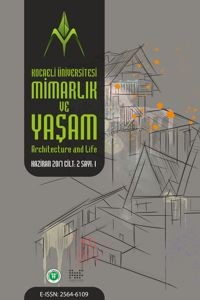Abstract
Beyoğlu
ve Şişli ilçelerinin arasında kalan Feriköy semtinin gelişimi 19. yüzyılın
sonlarına rastlamaktadır. Ayrıca, Feriköy’ün İstanbullu Rumların mesken tuttuğu
Tatavla (Kurtuluş) semti ile komşu olmasına rağmen ikamet alanı olarak rağbet
görmemesi dikkat çeker. Tanzimat Fermanı’nın ardından yapılan bir dizi hukuki
düzenlemelerden biri olan toprak hukukundaki değişiklikler semtin geleceğini
şekillendirmiştir. Böylece, Feriköy’e bir yandan Balkanlar’da toprağını
kaybedip gelen muhacirlerin, diğer yandan Beyoğlu’na artan rağbet nedeniyle
yerleşim imkanı bulamayan yabancıların ve Osmanlı tebasından gayrimüslimlerin
ikamet ettirildikleri görülmektedir. Meydana gelen gelişmeler idare açısından çözüm
bekleyen birçok sorunu üretmiştir. Yeni yerleşim alanları için yol, su gibi
ihtiyaçların temininin yanında okul ve karakol inşa etmek de idarenin görevleri
arasındadır. Söz konusu faaliyetlerin sürdürülebilir kılınması açısından vakıflara
ait mülklerin dönüştürülerek özel mülkiyete açılması gerekmiştir. Niteliği
itibariyle şahıs vakıflarının dönüştürülmesi mümkün olmadığından sultan
vakıflarına ait arazilerin (gayrısahih
vakıf arazi) bu amaçla kullanıldığı anlaşılmaktadır. Başbakanlık Osmanlı
Arşivi belgeleri; Feriköy semtinde Sultan Bayezid-i Veli vakfına ait arazilerin
bu şekilde dönüştürülerek kullanıldığını desteklemektedir. Bu bakış açısıyla
makalede, Feriköy’deki vakıf arazilerinin el değiştirme süreci bazı belgeler
ışığında değerlendirilmiştir.
References
- Dünden Bugüne İstanbul Ansiklopedisi (D.B.İ.A.), C:3, Kültür Bakanlığı ve Tarih Vakfı’nın Ortak Yayını, İstanbul, 1994.
- Ekinci, Ekrem Buğra, Osmanlı Hukuku Adalet ve Mülk, Arı Sanat Yayınları, İstanbul, 2008 İstanbul Ansiklopedisi, Reşad Ekrem Koçu, C: 10, Koçu Yayınları, İstanbul, 1971.
- Kenanoğlu, Mustafa Macit, “1858 Arazi Kanunnamesinin Osmanlı Siyasal ve Toplumsal Yapısı Üzerindeki Etkileri (1858-1876)”, Doktora Tezi, Ankara Üniversitesi Sosyal Bilimler Enstitüsü Kamu Yönetimi ve Siyaset Bilimi Anabilim Dalı, Ankara, 2002.
- Kostandov, Georgi P., İstanbullu Bulgarlar ve Eski İstanbul Geçmişten Günümüze Osmanlı Bakiyesi Bulgarlar Üzerine Bir Araştırma 1800-2000, Sanat Dükkanı Yayıncılık, İstanbul, 2011.
- Mundy, Martha, Richard Saumarez Smith, Modern Devlet’e Giden Yolda Mülk Siyaseti: Osmanlı Suriyesi’nde Hukuk Yönetim ve Üretim, Çev: Süleyman Kızıltoprak, Tarih Vakfı Yurt Yayınları, İstanbul, 2013.
- Onar, Sıddık Sami, Tanzimat’tan Cumhuriyet’e Türkiye Ansiklopedisi, C:3, İletişim Yayınları, İstanbul, 1985.
- Pervititch, Jacques, Sigorta Haritalarında İstanbul, Proje Koordinatörleri: Seden Ersoy, Çağatay Anadol, Tarih Vakfı, İstanbul.
- Şişli Rehberi (Ş.R.), Şişli Belediyesi, İstanbul, 1987.
- Tuncer, Hadiye, Osmanlı İmparatorluğu’nda Toprak Hukuku, Arazi Kanunları ve Kanun Açıklamaları, Tarım Bakanlığı Mesleki Mevzuat Serisi, Ankara, 1962.
Abstract
The
development of the Feriköy town between the districts of Beyoğlu and Şişli, is
found in the late 19th century. Moreover, although Feriköy is adjacent to the
Tatavla (Kurtuluş) neighbourhood, which the Greek residents of Istanbul live
in, it attracts attention that it is not popular as a residence area. Changes
in territorial law, one of a number of legal arrangements made after the
Imperial Edict of Gülhane, have shaped the future of the district. Thus, it is
seen that on the one hand the immigrants who lost their land in the Balkans and
on the other hand the non-resident foreigners who could not find a settlement
due to the increasing demand of Beyoğlu and the non-Muslims were resident in
Feriköy. The going-on developments produced many problems waiting to be solved
in terms of administration. For the new settlement areas, it is also among the
tasks of the administration to build schools and police stations as well as the
provision of roads and water needs. In order to make these activities
sustainable, it is necessary to convert the properties belonging to the
foundations and make them be open to private property. Since it is not possible
to transform individual foundations by nature, it is understood that the land
belonging to the sultan foundations (inaccurate foundation land) is used for
this purpose. Documents of the Prime Ministry Ottoman Archives support that in
Feriköy district, Sultan Bayezid-i Veli foundation's lands have been
transformed and used in this way. From this point of view, the process of
change of foundation lands in Feriköy has been evaluated in the light of some
documents.
References
- Dünden Bugüne İstanbul Ansiklopedisi (D.B.İ.A.), C:3, Kültür Bakanlığı ve Tarih Vakfı’nın Ortak Yayını, İstanbul, 1994.
- Ekinci, Ekrem Buğra, Osmanlı Hukuku Adalet ve Mülk, Arı Sanat Yayınları, İstanbul, 2008 İstanbul Ansiklopedisi, Reşad Ekrem Koçu, C: 10, Koçu Yayınları, İstanbul, 1971.
- Kenanoğlu, Mustafa Macit, “1858 Arazi Kanunnamesinin Osmanlı Siyasal ve Toplumsal Yapısı Üzerindeki Etkileri (1858-1876)”, Doktora Tezi, Ankara Üniversitesi Sosyal Bilimler Enstitüsü Kamu Yönetimi ve Siyaset Bilimi Anabilim Dalı, Ankara, 2002.
- Kostandov, Georgi P., İstanbullu Bulgarlar ve Eski İstanbul Geçmişten Günümüze Osmanlı Bakiyesi Bulgarlar Üzerine Bir Araştırma 1800-2000, Sanat Dükkanı Yayıncılık, İstanbul, 2011.
- Mundy, Martha, Richard Saumarez Smith, Modern Devlet’e Giden Yolda Mülk Siyaseti: Osmanlı Suriyesi’nde Hukuk Yönetim ve Üretim, Çev: Süleyman Kızıltoprak, Tarih Vakfı Yurt Yayınları, İstanbul, 2013.
- Onar, Sıddık Sami, Tanzimat’tan Cumhuriyet’e Türkiye Ansiklopedisi, C:3, İletişim Yayınları, İstanbul, 1985.
- Pervititch, Jacques, Sigorta Haritalarında İstanbul, Proje Koordinatörleri: Seden Ersoy, Çağatay Anadol, Tarih Vakfı, İstanbul.
- Şişli Rehberi (Ş.R.), Şişli Belediyesi, İstanbul, 1987.
- Tuncer, Hadiye, Osmanlı İmparatorluğu’nda Toprak Hukuku, Arazi Kanunları ve Kanun Açıklamaları, Tarım Bakanlığı Mesleki Mevzuat Serisi, Ankara, 1962.
Details
| Primary Language | Turkish |
|---|---|
| Subjects | Architecture |
| Journal Section | Kapak |
| Authors | |
| Publication Date | June 30, 2017 |
| Published in Issue | Year 2017 Volume: 2 Issue: 1 |


